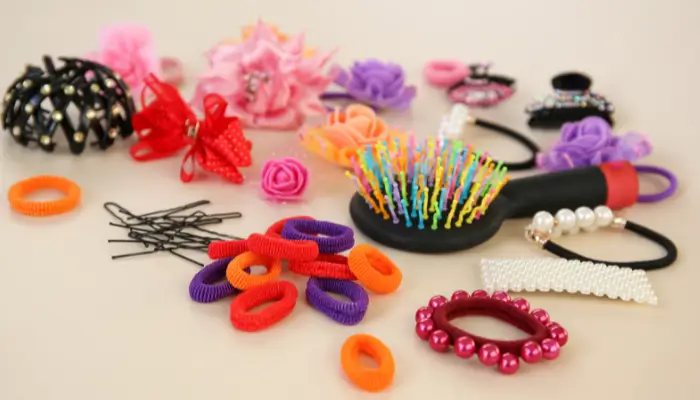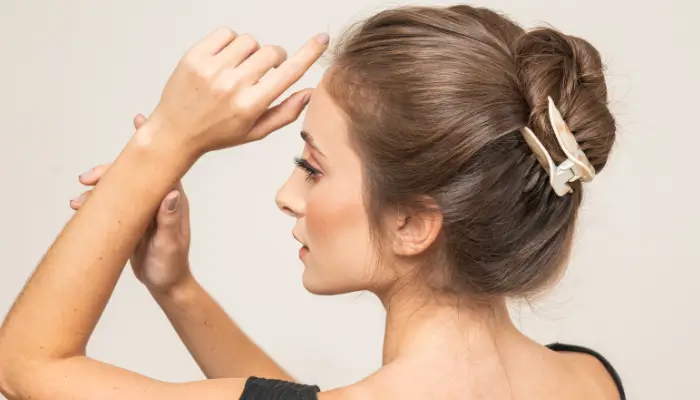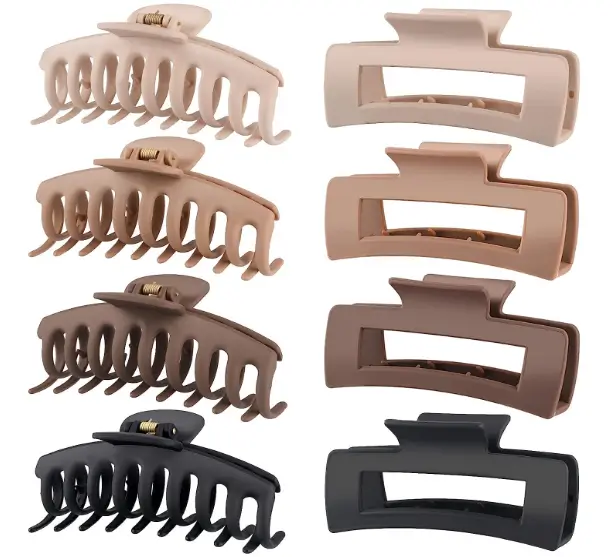When it comes to styling our hair, we often reach for various accessories like hair clips to achieve our desired look. However, there are concerns about the potential damage these clips can cause to our precious strands. From breakage and traction to pulling, it’s essential to understand how to use hair clips safely and maintain hair health.

While some hair accessories, such as hair ties and headbands, can be harsh on the hair and cause damage, hair clips offer a gentler alternative. But how do they compare to other options, and what steps can we take to prevent damage? Let’s explore the world of hair clips and unlock the secrets to maintaining fabulous locks without compromising on style.
Are Hair Clips Bad for Your Hair? Key Notes:
- Using hair clips can potentially cause damage to the hair, but proper usage and care can minimize the risk.
- Hair clips provide a gentler alternative to other accessories like hair ties and headbands.
- Choosing high-quality clips with functioning springs and smooth edges can help prevent breakage and snagging.
- Avoid wrapping hair too tightly and using hair clips on wet hair to protect your strands.
- When used correctly, hair clips can be a great styling option and give your hair a break from heat styling tools.
Common Hair Accessories and their Potential Damage
When it comes to styling our hair, we often rely on various accessories to achieve the desired look. However, not all hair accessories are created equal, and some can actually cause damage to our precious locks. Let’s take a closer look at common hair accessories and the potential damage they can inflict.
Hair Ties
One popular hair accessory that many of us use daily is the humble hair tie, particularly in the form of scrunchies. While hair ties can help keep our hair in place, they can also cause harm if used incorrectly. When pulled back tightly, hair ties can create traction on the hair, resulting in breakage and damage.
Headbands
Another common hair accessory is the headband. While headbands can add a stylish touch to our hairdos, some types, especially those with built-in combs, can put pressure on the hairline and temples. This continuous pressure can lead to hair breakage over time.
The Gentle Alternative: Hair Clips
Unlike hair ties and headbands, hair clips offer a gentler alternative for putting our hair up without causing excessive strain or damage. Hair clips securely hold our hair in place without creating traction or pulling on the strands. This makes them a great option for those who want to protect their hair while still enjoying stylish updos.
By using hair clips properly and following a few simple guidelines, we can prevent hair clip damage and keep our hair healthy and beautiful.
Article – Half Up Wedding Hair Accessories

Hair Clips vs. Hair Ties: Which is Better for Your Hair?
When it comes to choosing hair accessories, it’s essential to consider their impact on your hair health. Hair clips and hair ties are two popular choices, but which one is better? Let’s compare the two options and explore their effects on your hair.
The Potential Damage of Hair Ties
Hair ties, especially when pulled tightly, can cause damage to your hair. The constant tension and traction on the hair follicles at the root can lead to breakage and hair loss over time. This is particularly true if you frequently wear your hair in tight ponytails or buns.
The Gentle Approach of Hair Clips
On the other hand, hair clips provide a gentler alternative for styling your hair. Instead of stretching and pulling the hair, hair clips cocoon the strands, reducing the risk of breakage and traction damage. The proper use of hair clips can help you maintain the health of your hair while still enjoying different hairstyles.
Preventing Hair Clip Damage
To make sure that hair clips don’t cause any damage to your hair, there are a few things to keep in mind:
- Choose hair clips with functioning springs that provide a secure grip without pulling too tightly.
- Look for hair clips with smooth, seamless edges to avoid any snagging or breakage.
- Use hair clips that are suitable for your hair type and thickness. Clips that are too small can put excessive pressure on the hair, while clips that are too large may not hold the hair securely.
By following these tips, you can minimize the potential damage that hair clips may cause and keep your hair healthy and stylish.
| Comparison | Hair Clips | Hair Ties |
|---|---|---|
| Gentleness | Gently cocoon the hair without stretching | Apply tension and traction on the hair |
| Risk of Damage | Less risk of breakage and traction damage | Higher risk of breakage and traction damage |
| Size Options | Available in various sizes to suit different hair types | Usually one size fits all |
| Style Versatility | Offer a variety of styling options | Limited styling options |
Overall, hair clips are a better option for your hair compared to hair ties. They provide a gentle approach to styling and reduce the risk of damage and breakage. By choosing the right hair clips and using them correctly, you can enjoy various hairstyles while maintaining the health of your hair.
The Popularity of Claw Clips and Their Benefits
Claw clips have regained their popularity due to their convenience, comfort, and ability to provide a break from heat styling. These versatile accessories have become a favorite among celebrities and influencers for their simplicity and laid-back style. When used correctly, claw clips are gentle on the hair, making them a popular choice for those looking to maintain hair health while still enjoying stylish looks.
Top Selling Hair Clips On Amazon
Whether you’re running errands or attending a casual gathering, claw clips offer a quick and easy way to put your hair up without causing excessive strain or damage. They are suitable for various hair types and lengths and can be found in different sizes and designs to cater to individual preferences.
When it comes to purchasing claw clips, you have countless options available. They can be conveniently purchased online or found in various retailers, allowing you to select the perfect claw clip to match your style and hair type.
Claw Clips and Different Hair Types
When it comes to claw clips, it’s important to consider your hair type to ensure the best fit and minimize any potential damage. Those with super long hair, curly textured hair, or thicker, voluminous hair might find that certain claw clips are not suitable for their hair type. Flimsy claw clips can lose their spring or even break when used on thicker or longer hair, while people with textured hair may find that their curls get tangled in the clips.
To maintain hair health and prevent breakage, it’s crucial to choose high-quality claw clips that can accommodate the thickness and length of your hair. Opt for sturdy clips that provide a secure grip without exerting excessive tension or causing discomfort. Investing in well-made claw clips can help you achieve the stylish look you desire while keeping your hair safe and healthy. Hair clip care is also essential and super easy. Simply store clips in a safe place and clean every now and then to rid of any bacteria or potential fungal build up around the grips, claws or springs. Thus easily preventing hair clip damage from additional causing potential damage to your hair.
| Hair Type | Recommended Claw Clip |
|---|---|
| Super long hair | Large-sized claw clips with stronger springs |
| Curly textured hair | Claw clips with wider teeth or larger spacing between teeth to prevent tangling |
| Thicker, voluminous hair | Stronger and larger claw clips that can accommodate more hair |
Expert Tip:
For those with thicker hair, consider slightly twisting or partially folding your hair before securing it with a claw clip. This technique can help distribute the weight of your hair more evenly and make it easier to fit within the clip, reducing the risk of breakage.
Styling Options with Claw Clips
When it comes to styling your hair, claw clips offer a range of versatile options that not only keep your hair in place but also help maintain its overall health. Unlike some other hair accessories, claw clips provide a secure hold without causing damage or strain to your strands. Let’s explore some popular and effortless styles you can achieve with claw clips:
Ponytail Twists
One of the easiest and most popular hairstyles with claw clips is the ponytail twist. Simply gather your hair at the nape of your neck, twist it into a neat coil, and secure it with a claw clip. This style keeps your hair off your face while still allowing for a cute and classy look.
French Twists
A French twist is an elegant updo that remains timeless. To create this style with a claw clip, gather your hair at the nape of your neck, twist it upwards towards the crown of your head, and secure it with a claw clip. This style is perfect for special occasions or when you want to add a touch of sophistication to your everyday look.
These are just a few examples of the many styling options you can explore with claw clips. The versatility of these clips allows you to experiment with different looks while maintaining the health of your hair. Remember, it’s important to choose high-quality claw clips with smooth edges to prevent any potential damage.
| Styling Options | Description |
|---|---|
| Ponytail Twists | Create a neat and stylish ponytail by twisting your hair and securing it with a claw clip. |
| French Twists | Elevate your look with an elegant French twist by twisting your hair upwards and securing it with a claw clip. |
| Half-Up Styles | Give your hair a playful and chic look by twisting and securing half of your hair up with a claw clip. |
| Bun Styles | Create a quick and effortless bun by twisting your hair into a coil and securing it with a claw clip. |
These styling options not only allow you to switch up your look but also provide a gentle and stress-free alternative to other hair accessories that may cause damage or breakage. Experiment with different styles and find what works best for your hair type and personal preferences.
Avoiding Hair Damage with Claw Clips
When it comes to using claw clips, taking proper precautions can help prevent any potential damage to your hair. By following a few simple guidelines, you can enjoy the convenience and style of hair clips while maintaining the health of your hair.
Choosing the Right Clips
One of the key aspects of preventing hair damage is selecting the right claw clips. Ensure that the clips you choose have functioning springs that provide a secure grip, as loose or faulty springs can lead to hair breakage. Additionally, opt for clips with smooth and seamless edges to minimize the risk of snagging or causing any unwanted damage to your hair.
Mindful Styling
To maintain the health of your hair, make sure not to wrap your hair too tightly when using a claw clip. Tight hairstyles can exert excessive pressure on your hair, leading to breakage. Instead, go for a looser and more relaxed style that allows your hair to breathe and move freely.
It’s also essential to avoid using a claw clip on wet hair. Wet hair is more fragile and prone to damage, and using a clip when your hair is wet can increase the risk of breakage. Let your hair air dry or use a blow dryer on a gentle setting before styling it with a claw clip.
Caring for Your Hair
Proper hair care goes hand in hand with preventing damage when using hair clips. Maintain a healthy hair care routine by regularly washing and conditioning your hair. This helps keep your hair strong and nourished, minimizing the risk of breakage.
Additionally, be mindful when removing the clip from your hair. Gently unwind the clip without forcefully pulling or tugging on your hair. This ensures that you don’t cause unnecessary stress to your strands, helping to prevent damage.
By following these tips and guidelines, you can enjoy the benefits of claw clips without compromising the health of your hair. Remember to choose high-quality clips, style your hair with care, and prioritize hair health in your routine.
Claw Clips for Thinning Hair
For those experiencing thinning hair, choosing the right hair accessory is crucial. Tight ponytails and headbands can put additional stress on the hairline and scalp, potentially exacerbating hair thinning. Thankfully, claw clips offer a gentler alternative that can help minimize the risk of further damage while providing a safe option for styling.
When it comes to hair health, it’s important to make thoughtful choices to preserve and maintain your hair. Opting for a claw clip over other accessories can help alleviate the tension and pressure on your delicate strands, creating a more comfortable and secure hold.
“Claw clips are a great option for individuals with thinning hair, as they distribute the weight of the hair more evenly, reducing the strain and preventing additional breakage,” says Dr. Christina Lee, a renowned trichologist.
With their sturdy grip and versatility, claw clips can hold your hair in place without causing unnecessary tension or tugging. This ensures that your hair remains intact, minimizing the risk of further thinning or damage.
Maintaining Hair Health with Claw Clips
If you have thinning hair, here are some tips to help you maintain hair health while using claw clips:
- Choose a claw clip with a suitable size for your hair volume. Opt for larger sizes for thicker or longer hair to ensure a secure hold without excessive pressure.
- Select claw clips with smooth edges to prevent any snagging or breakage, as rough edges can lead to hair damage.
- Avoid wrapping your hair too tightly when securing it with a claw clip. Gentle tension is sufficient to keep your style in place.
- Never use a claw clip on wet hair, as it is more fragile and prone to breakage. Allow your hair to dry completely before styling.
By following these simple guidelines, you can style your hair with confidence using claw clips while minimizing the risk of further damage to your thinning hair. Remember, it’s crucial to prioritize hair health and choose accessories that promote gentle hairstyling.
Round Up
Are hair clips bad for your hair? After examining the potential damage that hair accessories can cause, it is clear that hair clips offer a gentler alternative for maintaining hair health. However, whether hair clips are bad for your hair ultimately depends on your individual hair type and how you use them. To prevent any damage, it is crucial to take proper care when using hair clips.
If you have thinning hair, using a claw clip can be a safer option compared to tight ponytails or headbands that can exacerbate hair thinning. By choosing high-quality clips with functioning springs and smooth edges, you can minimize the risk of damage and breakage. It is also important to avoid wrapping your hair too tightly and to avoid using a hair clip on wet hair, as it is more fragile in its wet state.
Remember, hair health should always be a priority. By embracing a delicate approach to styling and selecting hair accessories that are suitable for your hair type, you can maintain and protect your hair’s overall health. So, the next time you reach for a hair clip, keep these tips in mind and enjoy using this versatile accessory without compromising your hair’s well-being.
FAQ
Are hair clips bad for your hair?
Hair clips, when used correctly, are generally considered to be a better option for your hair compared to hair ties. They provide a gentler alternative for putting hair up without causing excessive strain or damage.
What potential damage can common hair accessories cause?
Hair ties, such as scrunchies, can cause hair traction and breakage if pulled tightly. Headbands, especially those with built-in combs, can put pressure on the hairline and temples, leading to hair breakage.
Which is better for your hair, hair clips or hair ties?
Hair clips are generally considered to be a better option for your hair compared to hair ties. Hair ties, especially when pulled tightly, can cause more damage to the hair follicles at the root. Hair clips cocoon the hair rather than stretching it, resulting in less strain and breakage.
What are the benefits of claw clips?
Claw clips have become popular again due to their convenience, comfort, and ability to give the hair a break from heat styling. They provide a gentle option for putting hair up without causing excessive damage.
Do claw clips work for all hair types?
While claw clips can be suitable for most hair types, those with super long hair, curly textured hair, and thicker, voluminous hair may find that some claw clips are not suitable for their hair type. It’s essential to choose high-quality claw clips that can accommodate the thickness and length of your hair.
What are the styling options with claw clips?
Claw clips offer numerous styling options, such as ponytail twists and French twists, without causing damage to the hair. These styles provide a quick and easy way to put your hair up without putting excessive strain on the strands.
How can I avoid hair damage with claw clips?
To avoid damaging your hair with claw clips, it’s important to choose clips with functioning springs that don’t lose their grip easily. Clips should have smooth and seamless edges to prevent any snagging or breakage. Avoid wrapping your hair too tightly or using a claw clip on wet hair, as it is more fragile when wet.
Are claw clips suitable for thinning hair?
Claw clips can be a more gentle option for those with thinning hair. Tight ponytails, cheap hair clips or headbands can add to hair thinning by the hair clip pulling back the hairline and scalp. Choosing a claw clip over other accessories can help minimize the risk of exacerbating hair thinning and provide a safer option for styling.
What is the conclusion about hair clips and hair health?
Maintaining hair health with hair clips. Whether hair clips are bad for your hair depends on your hair type and how you use them. It’s important to take proper care when using any hair accessory. If you have thinning hair, using a claw clip can be a gentler alternative. Remember to use high-quality clips, avoid wrapping your hair too tightly, and embrace a delicate approach to styling to minimize the risk of damage.





